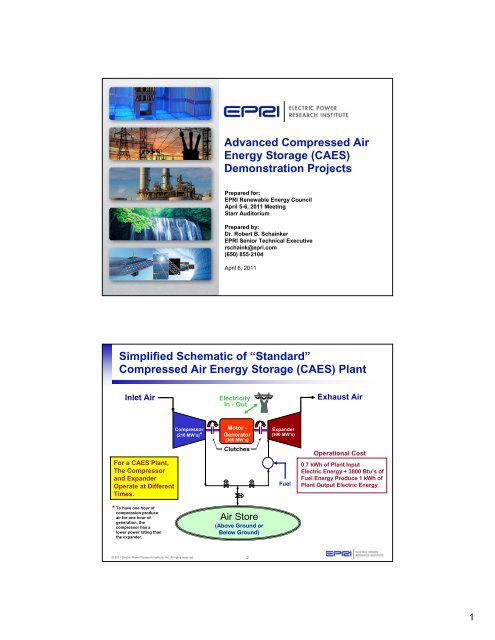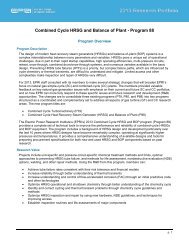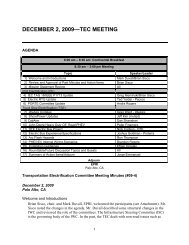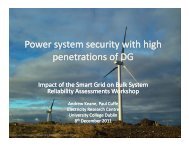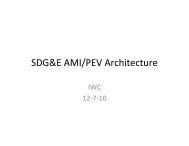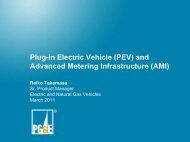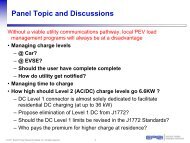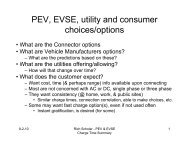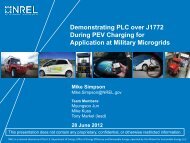Advanced Compressed Air Energy Storage (CAES) Demonstration ...
Advanced Compressed Air Energy Storage (CAES) Demonstration ...
Advanced Compressed Air Energy Storage (CAES) Demonstration ...
Create successful ePaper yourself
Turn your PDF publications into a flip-book with our unique Google optimized e-Paper software.
Inlet <strong>Air</strong><br />
© 2011 Electric Power Research Institute, Inc. All rights reserved.<br />
<strong>Advanced</strong> <strong>Compressed</strong> <strong>Air</strong><br />
<strong>Energy</strong> <strong>Storage</strong> (<strong>CAES</strong>)<br />
<strong>Demonstration</strong> Projects<br />
Prepared for:<br />
EPRI Renewable <strong>Energy</strong> Council<br />
April 5-6, 2011 Meeting<br />
Starr Auditorium<br />
Prepared by:<br />
Dr. Robert B. Schainker<br />
EPRI Senior Technical Executive<br />
rschaink@epri.com<br />
(650) 855-2104<br />
April 6, 2011<br />
Simplified Schematic of “Standard”<br />
<strong>Compressed</strong> <strong>Air</strong> <strong>Energy</strong> <strong>Storage</strong> (<strong>CAES</strong>) Plant<br />
For a <strong>CAES</strong> Plant,<br />
The Compressor<br />
and Expander<br />
Operate at Different<br />
Times.<br />
*<br />
To have one hour of<br />
compression produce<br />
air for one hour of<br />
generation, the<br />
compressor has a<br />
lower power rating than<br />
the expander.<br />
Electricity<br />
In - Out<br />
Compressor<br />
(210 MW’s)*<br />
Motor -<br />
Generator<br />
(300 MW’s)<br />
Expander<br />
(300 MW’s)<br />
Clutches<br />
<strong>Air</strong> Store<br />
(Above Ground or<br />
Below Ground)<br />
2<br />
Fuel<br />
Exhaust <strong>Air</strong><br />
Operational Cost<br />
0.7 kWh of Plant Input<br />
Electric <strong>Energy</strong> + 3800 Btu’s of<br />
Fuel <strong>Energy</strong> Produce 1 kWh of<br />
Plant Output Electric <strong>Energy</strong><br />
1
Geologic Formations Potentially Suitable for<br />
<strong>CAES</strong> Plants That Use Underground <strong>Storage</strong><br />
© 2011 Electric Power Research Institute, Inc. All rights reserved.<br />
© 2011 Electric Power Research Institute, Inc. All rights reserved.<br />
110MW-26Hr Alabama <strong>CAES</strong> Plant<br />
ARRA Stimulus (DOE Cost Shared Demo Projects)<br />
{American Recovery and Reinvestment Act of 2009}<br />
� DOE published final Funding Opportunity Announcement<br />
June 25, 2009. Bids were due and submitted Aug 26, 2009.<br />
� EPRI staff assisted two utilities to submit and win contracts<br />
3<br />
– NYSEG: 150 MW – 10 Hr Adv. <strong>CAES</strong> Plant Using Underground<br />
Salt Cavern for the <strong>Air</strong> Store<br />
• Received $30M from DOE<br />
– PG&E: 300 MW – 10 Hr. Adv. <strong>CAES</strong> Plant Using Underground<br />
Depleted Gas Field or Porous Rock Media for the <strong>Air</strong> Store<br />
• Received $25M from DOE<br />
� DOE Utility Contracts Sent To Both Utilities November 15,<br />
2010<br />
• NYSEG Signed Their Contract November 30, 2010<br />
• PG&E Sign Their Contract February 4, 2010<br />
4<br />
2
EPRI Adv. <strong>CAES</strong> Demo Project:<br />
Phased Approach<br />
Project Phases:<br />
1. Econ, Engnrg Design, Permitting, Costing, Vendor Quotes and Engnrg Trade-Off Studies<br />
2. Construct Plant<br />
3. Monitor Plant Performance and Reliability<br />
Schedule (Optimistic): 2009 2010 2011 2012 2013 2014 2015<br />
150MW / 300 MW - 10 Hr. Plant<br />
Using Below Ground <strong>Air</strong> Store<br />
15 MW / 50 MW - 2 Hr. Plant<br />
Using Above Ground <strong>Air</strong> Store<br />
Notes:<br />
1. Two utilities are hosting the planned construction of <strong>Advanced</strong> <strong>CAES</strong> Plants (PG&E<br />
and NYSEG), both using underground air storage systems<br />
2. Host for plant using above ground air store is still a possibility<br />
3. All Adv <strong>CAES</strong> Demo Project participants will obtain project results from all work<br />
performed during all phases of the project and for all types of plants built.<br />
© 2011 Electric Power Research Institute, Inc. All rights reserved.<br />
© 2011 Electric Power Research Institute, Inc. All rights reserved.<br />
5<br />
APPENDIX<br />
NYSEG <strong>Advanced</strong> <strong>CAES</strong> Demo Plant Location<br />
6<br />
• 3 miles north of Watkins Glen on the<br />
west side of Seneca Lake.<br />
• Site owned by US Salt, subsidiary of<br />
<strong>Energy</strong> Midstream, LLC. Has been an<br />
active solution salt mine for the last 100<br />
years.<br />
• <strong>Energy</strong> will re-open and test a solutionmined<br />
salt cavern capable of 0.5 BCF at<br />
maximum pressure and a working<br />
volume of at least a 0.32 BCF.<br />
• The cavern and plant will have the<br />
capacity to provide more than 16 hours<br />
of a combination of power production.<br />
• Site features an existing high- pressure<br />
natural gas pipeline and brine treatment<br />
facilities, and is located 1.5 miles from<br />
high voltage transmission lines.<br />
• Site is ideally suited for future<br />
increases in plant capacity due to the<br />
existence of numerous depleted salt<br />
caverns.<br />
3
APPENDIX<br />
PG&E <strong>Advanced</strong> <strong>CAES</strong> Demo Plant Location<br />
© 2011 Electric Power Research Institute, Inc. All rights reserved.<br />
15 MW – 2 Hr. Adv. <strong>CAES</strong> Plant Using Pipeline<br />
Type of Above-Ground <strong>Air</strong> <strong>Storage</strong> System<br />
© 2011 Electric Power Research Institute, Inc. All rights reserved.<br />
7<br />
8<br />
4
Comparison of First Generation and<br />
<strong>Advanced</strong> <strong>CAES</strong> Plant Designs<br />
First generation <strong>CAES</strong> plant design (i.e., Alabama plant design)<br />
– Complex set of turbomachinery<br />
– Customized high pressure combustor<br />
– Meets NOx air quality emission standards with additional<br />
auxiliary equipment<br />
– Cannot process stored air that has any oxygen depletion<br />
– Construction time is two tothree years<br />
<strong>Advanced</strong> <strong>CAES</strong> plant design<br />
– Expected to have lower capital cost and lower operating cost<br />
than the first generation plant design<br />
– Expected to meet existing air emission standards (including<br />
NOx) without additional auxiliary equipment added to the plant<br />
– Construction is anticipated to take two to three years<br />
© 2011 Electric Power Research Institute, Inc. All rights reserved.<br />
<strong>CAES</strong> Demo Project Newsletter (Published Quarterly)<br />
© 2011 Electric Power Research Institute, Inc. All rights reserved.<br />
9<br />
10<br />
5
Questions ?<br />
© 2011 Electric Power Research Institute, Inc. All rights reserved.<br />
Alabama <strong>CAES</strong> Plant: Dresser-Rand Design Schematic<br />
Updated To 2011 Turbomachinery + 2011 NOx Standards<br />
Aftercooler<br />
Compressors (112 MW)<br />
© 2011 Electric Power Research Institute, Inc. All rights reserved.<br />
11<br />
12<br />
Expanders (134 MW)<br />
Motor<br />
HP-2 HP-1 IP LP /Gen<br />
LP HP<br />
Note:<br />
Alabama Cavern:<br />
Distance to Surface = 1500 Ft<br />
Height = 1000 Ft<br />
Volume = 20 MCF<br />
Intercoolers<br />
SSS Clutches<br />
Ambient<br />
<strong>Air</strong><br />
<strong>Air</strong> <strong>Storage</strong> System<br />
(Salt, Porous Rock, Hard Rock)<br />
*<br />
SCR<br />
*<br />
Fuel<br />
LP<br />
*<br />
730 psi<br />
Possible NOx<br />
Technical Issues<br />
*<br />
HP<br />
Exhaust<br />
Stack<br />
Recuperator<br />
Total Plant Output<br />
~ 134 MW’s – 10 Hr/Module<br />
Heat Rate<br />
<strong>Energy</strong> Ratio<br />
APPENDIX<br />
3960<br />
0.83<br />
6
Alabama <strong>CAES</strong> Plant<br />
110 MW Turbomachinery Hall<br />
© 2011 Electric Power Research Institute, Inc. All rights reserved.<br />
CT Module<br />
© 2011 Electric Power Research Institute, Inc. All rights reserved.<br />
13<br />
14<br />
Expansion Turbines<br />
Clutch<br />
Motor-Generator<br />
Clutch<br />
Compressors<br />
<strong>Advanced</strong> <strong>CAES</strong> Plant: Schematic<br />
---Second Generation “Chiller” Design- - -<br />
Estimated Cap. Cost (2011 $) ~ $700/kW to $800/kW + Substation, Permits & Contingencies & NOX Control<br />
(For Salt Geology)<br />
<strong>Air</strong><br />
Compressor<br />
Intercoolers<br />
• <strong>Storage</strong><br />
<strong>Storage</strong><br />
Motor<br />
<strong>Air</strong><br />
Fuel<br />
Combustion Turbine<br />
Constant Output Pressure Regulation Valve<br />
The <strong>CAES</strong> plant design and<br />
technology presented above is<br />
described in U.S. Patent Numbers<br />
7389644 and 4872307, invented by Dr.<br />
Michael Nakhamkin, Chief<br />
Technology Officer, <strong>Energy</strong> <strong>Storage</strong><br />
and Power LLC. Use of this<br />
technology may require a license.<br />
Exhaust<br />
Heat Rate<br />
<strong>Energy</strong> Ratio<br />
APPENDIX<br />
APPENDIX<br />
Expander<br />
Recuperator<br />
3810<br />
0.70<br />
7
Underground Natural Gas <strong>Storage</strong><br />
Facilities in the Lower 48 United States<br />
�Depleted<br />
Gas Fields<br />
� Porous Rock/Aquifers<br />
� Salt Caverns<br />
© 2011 Electric Power Research Institute, Inc. All rights reserved.<br />
Simplified Schematic of “Standard” Simple<br />
Cycle Combustion (CT) 100 MW Plant<br />
Inlet <strong>Air</strong><br />
Compressor<br />
Consumes 200<br />
MW’s of Power<br />
Compressor<br />
(200 MW’s)<br />
© 2011 Electric Power Research Institute, Inc. All rights reserved.<br />
15<br />
Electricity<br />
Out<br />
Generator<br />
Output:<br />
100 MWs<br />
16<br />
Expander<br />
(300 MW’s)<br />
Fuel<br />
Exhaust <strong>Air</strong><br />
Operational Cost<br />
APPENDIX<br />
APPENDIX<br />
10,000 Btu’s of Fuel <strong>Energy</strong><br />
Produces 1 kWh of Plant<br />
Output Electric <strong>Energy</strong><br />
For a CT Plant, The Compressor and Expander Operate at The Same Time. The<br />
Expander Produces About 300 MW’s of Power and the Compressor Consumes<br />
About 200 MW’s of Power; Thus, the Net CT Output is 100 MW’, which means the<br />
CT Capital Cost on a $/kW basis is about Three (3) Times More Expensive than the<br />
<strong>CAES</strong> Capital Cost, Without Accounting For The Costs of the <strong>Air</strong> Store, Generator,<br />
Valves, Clutches and Balance of Plant.<br />
8


